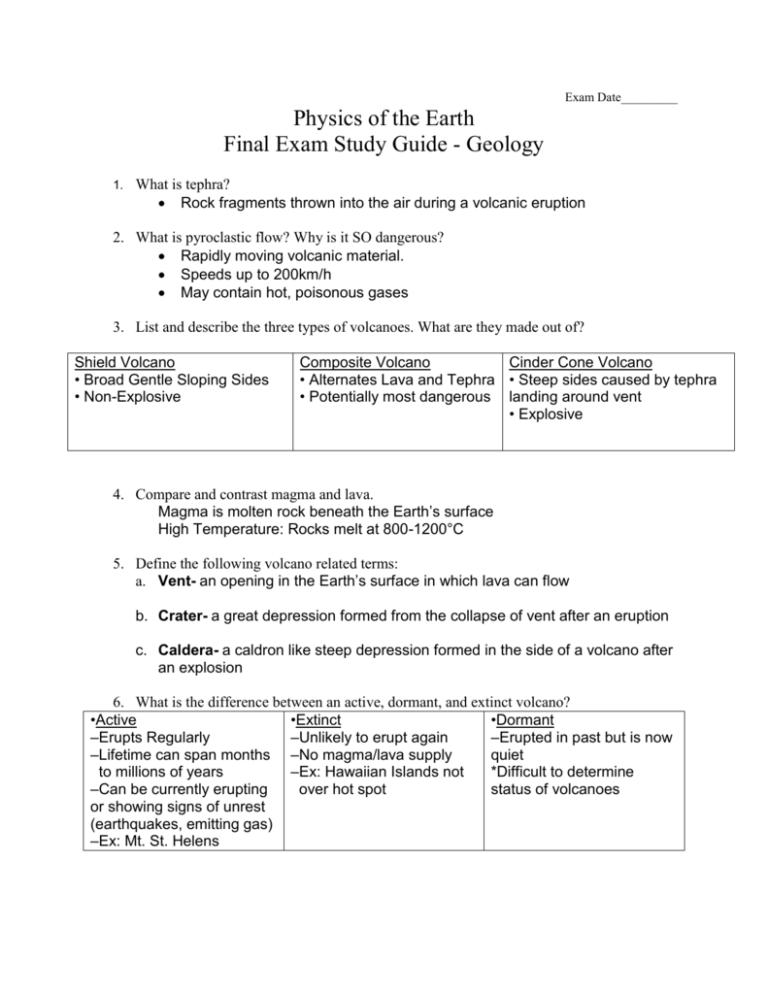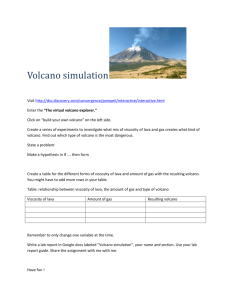Geology Final Exam Review
advertisement

Exam Date_________ Physics of the Earth Final Exam Study Guide - Geology 1. What is tephra? Rock fragments thrown into the air during a volcanic eruption 2. What is pyroclastic flow? Why is it SO dangerous? Rapidly moving volcanic material. Speeds up to 200km/h May contain hot, poisonous gases 3. List and describe the three types of volcanoes. What are they made out of? Shield Volcano • Broad Gentle Sloping Sides • Non-Explosive Composite Volcano Cinder Cone Volcano • Alternates Lava and Tephra • Steep sides caused by tephra • Potentially most dangerous landing around vent • Explosive 4. Compare and contrast magma and lava. Magma is molten rock beneath the Earth’s surface High Temperature: Rocks melt at 800-1200°C 5. Define the following volcano related terms: a. Vent- an opening in the Earth’s surface in which lava can flow b. Crater- a great depression formed from the collapse of vent after an eruption c. Caldera- a caldron like steep depression formed in the side of a volcano after an explosion 6. What is the difference between an active, dormant, and extinct volcano? •Active •Extinct •Dormant –Erupts Regularly –Unlikely to erupt again –Erupted in past but is now –Lifetime can span months –No magma/lava supply quiet to millions of years –Ex: Hawaiian Islands not *Difficult to determine –Can be currently erupting over hot spot status of volcanoes or showing signs of unrest (earthquakes, emitting gas) –Ex: Mt. St. Helens 7. What are hotspots? (Give an example) Hot Spots are unusually hot regions of Earth’s mantle where plumes of magma rise to surface Located away from plate boundaries Example: Hawaii 8. If volcano A is further from a hotspot than volcano B, which volcano is older? Volcano A is further from the hotspot. Volcano A is older. 9. What is viscosity? Viscosity is the internal resistance to flow •Low Viscosity – Moves fast (Less thick) •High Viscosity – Moves slow (More thick) 10. How do P waves move? P-Waves squeeze and pull rocks in the same direction as the wave travels 11. How do S waves move? S-Waves cause rocks to move at right angles to the direction of the wave 12. How do surface waves move? Surface Waves move rocks up and down, as well as side-to-side Motion is similar to an ocean wave 13. What is an earthquakes epicenter? The Epicenter is the point on Earth’s surface directly above the focus 14. What is an earthquakes focus? Earthquakes originate at a point Focus is usually below the surface 15. In what order do seismic waves arrive at a seismograph? P-Waves S-Waves Surface Waves 16. What are the steps for locating an earthquake’s epicenter? How many locations with data do you need to determine the epicenter? Epicenters are located by the separation between S- and P-waves on a seismogram Cannot use one location to map epicenter Need to use three or more seismic stations Time can be measured in same way Three locations should meet at the epicenter 17. List and describe the three types of faults. Reverse Faults are fractures that result from horizontal compression Shortens crust horizontally Normal Faults are fractures caused by horizontal tension Lengthens crust horizontally Strike-Slip Faults are fractures caused by horizontal shear Motion is mainly horizontal 18. Describe shearing forces. Shear is stress that causes a material to twist 19. Describe compression forces. Compression is stress that decreases the volume of material 20. Describe tension forces. Tension is stress that pulls a material apart 21. What is a seismic gap? Segment of an active fault that has not slipped in an unusually long time when compared with other segments along the same structure. 22. List and describe the scales used to measure earthquakes. Moment Magnitude Scale includes: Size of fault rupture Amount of movement along fault Rocks’ stiffness Modified Mercalli Scale assesses damage from a quake Richter Scale is based on the largest waves generated by the quake 23. What is a tsunami? A large wave of water caused by an underwater earthquake 24. What is the theory of continental drift? Who developed this theory? Hypothesis that Earth’s continents were joined as a single landmass that broke apart about 200 mya (million years ago) and slowly moved to their present locations Alfred Wegener 25. What evidence was there for continental drift? Explain. Fossils-Similar fossils of several different plants and animals that once lived near each other found on widely separated continents Land animals did not swim across ocean Rock Formations- Rock types found in Appalachian Mountains similar to those found in Greenland and Europe Climatic Evidence- Coal deposits in Antarctica indicate that the climate was much warmer in the past Must have been located closer to the equator before it drifted 26. What were the flaws of continental drift? Explain. Not able to explain what force was large enough to move such large pieces of earth over a great distance Not able to explain how the ocean basins were not shattered, move through solids






